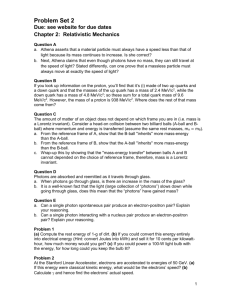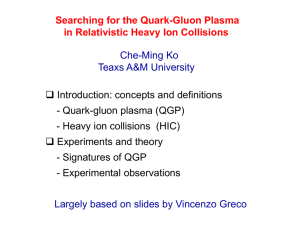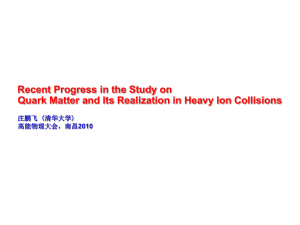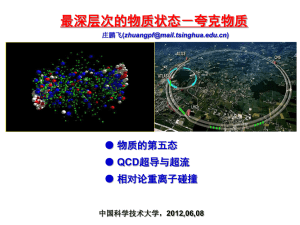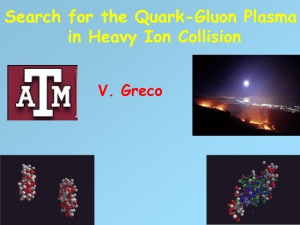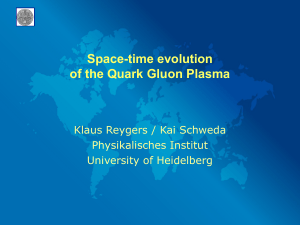Introduction to Heavy Ion Physics
advertisement
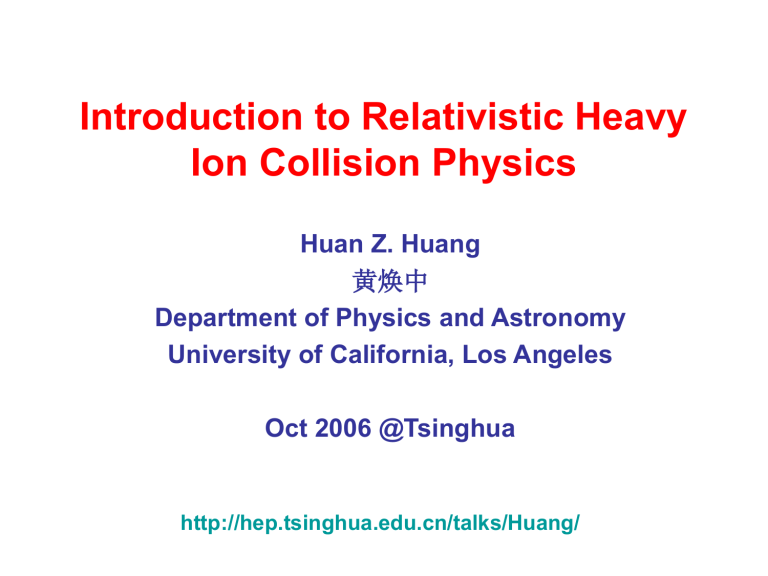
Introduction to Relativistic Heavy Ion Collision Physics Huan Z. Huang 黄焕中 Department of Physics and Astronomy University of California, Los Angeles Oct 2006 @Tsinghua http://hep.tsinghua.edu.cn/talks/Huang/ Two Puzzles of Modern Physics -- T.D.Lee • Missing Symmetry – all present theories are based on symmetry, but most symmetry quantum numbers are NOT conserved. • Unseen Quarks – all hadrons are made of quarks, yet NO individual quark has been observed. Vacuum As A Condensate • Vacuum is everything but empty! • The complex structure of the vacuum and the response of the vacuum to the physical world breaks the symmetry. • Vacuum can be excited! We do not understand vacuum at all ! A Pictorial View of Micro-Bangs at RHIC Thin Pancakes Lorentz g=100 Huge Stretch Nuclei pass The Last Epoch: thru each other Transverse Expansion Final Freezeout-High Temperature (?!) < 1 fm/c Large Volume Au+Au Head-on Collisions 40x1012 eV ~ 6 micro-Joule Human Ear Sensitivity ~ 10-11 erg = 10-18 Joule A very loud Bang, indeed, if E Sound…… Vacuum Engineering ! High Energy Nucleus-Nucleus Collisions initial state hadronic phase and freeze-out QGP and hydrodynamic expansion pre-equilibrium hadronization Physics: 1) Parton distributions in nuclei 2) Initial conditions of the collision 3) a new state of matter – Quark-Gluon Plasma and its properties 4) hadronization Kinematic Variables Rapidity: 1 E PZ y ln( ) 2 E PZ 1 P PZ ) ln(tan ) Pseudo-rapidity: ln( 2 P PZ 2 Transverse Momentum: pT p p Transverse Mass: mT p m 2 X 2 T 2 Y 2 0 Useful Expressions E mT cosh y pZ mT sinh y z tanh y dpz Edy Feymann xF: pL* pL* xF * S pmax 2 q2 ( pi p f )2 ; Q 2 q2 Bjorken x: (Ei E f ) Q2 x 2 M Light-cone x+: ( E pz ) x ( E pz )beam Cross Sections sTotal = Number of Reactions Number of Beam Particles X Scattering Center / Area Dimension [L2] sTotal = sinel + sel sinel= sSD + sND SD: Singly Diffractive ND: Non-Diffractive 3 d Differential Cross Section: 3s d p d 3 p dpx dp y dpz p 2dp sin dd Question: differential cross section vs total cross section? Invariant Cross Sections Invariant Differential Cross Section: E d3s/d3p d 2s 2pT dpT dy d 2s 2mT dmT dy 2 d N Invariant Multiplicity Density: N ev 2pT dpT dy E d3n/d3p d 2N N ev 2mT dmT dy Experimental Considerations: Efficiency, Acceptance, Decay Correction, Target-out Correction. Order of Magnitude Geometrical CS: pp r2 = (1fm)2 = 32 mb Au+Au Collisions: Rau = 1.2 A1/3 = 6.98 fm bmax=(2R)2 = 6 barn 1 barn = 10-24 cm2 Regge Theory: stotal=XS0.0808 + YS-0.4525 p-pbar 21.70 p-p 21.70 98.39 mb 56.08 mb Pomeron r,w,f,a,…. HIJING: minijet production Luminosity at Collider L= NB2 B v / U A B Number of bunches per beam NB Number of particles per bunch v velocity of particles U circumference of the ring A beam cross section at the collision Relativistic Heavy Ion Collider: 3 gN L f rev B 2 N N Invariant Transverse 95% Emittance * the beta function 2 B * RHIC Numbers RHIC Design: B NB L sNN Au Beam 57 109 2x1026 200 GeV Collision Rate: L x s 1200 Hz proton Beam 1011 1x1031 cm-2s-1 500 GeV 0.7 MHz RHIC Complex Relativistic Heavy Ion Collider --- RHIC STAR Au+Au 200 GeV N-N CM energy Polarized p+p up to 500 GeV CM energy Building Blocks of Hadron World Molecules Atoms Nucleus Proton (uud) Electrons Neutron (udd) Hyperons (s…) Mesons Exotics (q-q) (qqqq-q,…) Strong interaction is due to color charges and mediated by gluons. Gluons carry color charges too. Baryon Density: r = baryon number/volume normal nucleus r0 ~ 0.15 /fm3 ~ 0.25x1015 g/cm3 Temperature, MeV ~ 1.16 x 1010 K 10-6 second after the Big Bang T~200 MeV Energy Scale and Phase Transition Entity Energy Dimension Physics Bulk Property P/T Atom 10’s eV 10-10 m Ionization e/Ion Plasma No Nucleus 8 MeV 10-14 m Multifrag. Liquid-Gas Y(?) QCD 200 MeV 10-15 m Deconfine. QGP Y(?) EW 100 GeV 10-18 m P/CP GUT 1015-16 GeV Supersymmetry TOE 1019 GeV Superstring Baryon Asymmetry Y(?) Salient Feature of Strong Interaction Asymptotic Freedom: Quark Confinement: Coupling Strength 庄子天下篇 ~ 300 B.C. 一尺之棰,日取其半,万世不竭 Take half from a foot long stick each day, You will never exhaust it in million years. q QCD q Shorter distance q (GeV) Momentum Transfer q q q Quark pairs can be produced from vacuum No free quark can be observed QCD on Lattice Transition from quarks to hadrons – DOF ! QGP – not an ideal Boltzmann gas ! Lattice: current status • technical progress: finer mesh size, physical quark masses, improved fermion actions phase-transition: smooth, rapid cross-over EoS at finite μB: in reach, but with large systematic uncertainties critical temperature: TC180 MeV Fodor & Katz, hep-lat/0110102 Rajagopal & Wilczek, hep-ph/0011333 Quark-Hadron Phase Transition QGP – micro-second after the Big Bang The Melting of Quarks and Gluons -- Quark-Gluon Plasma -Matter Compression: Vacuum Heating: Deconfinement High Baryon Density -- low energy heavy ion collisions -- neutron starquark star High Temperature Vacuum -- high energy heavy ion collisions -- the Big Bang QCD Phase Transition early universe Chemical Temperature Tch [MeV] 250 RHIC 200 quark-gluon plasma SPS 150 AGS Lattice QCD deconfinement chiral restoration thermal freeze-out 100 SIS hadron gas 50 neutron stars atomic nuclei 0 0 200 400 600 800 1000 1200 Baryonic Potential B [MeV] What do experimental data points indicate and how were these points obtained ? Nuclear Collision Geometry Number of Participants Impact Parameter Particle Production is assumed to be directly related to the impact parameter or number of participant nucleons. Number of Participant Nucleons a) Geometrical Interpretation of Observables A monotonic relation between the observable and collision centrality is assumed b) Estimate from direct measurement missing energy from Zero-degree calorimeter from dn/dy of protons…. Directly Determining NPART Best approach (for fixed target!): – Directly measure in a “zero degree calorimeter” – N PART 2 A E ZDC (for A+A collisions) E PerNucleon NA50 – Strongly (anti)-correlated with produced transverse energy: ET EZDC ET Number of Participant Nucleons c) Dynamical Model Tune to fit experimental measurement From model to convert measurement to impact parameter and number of participant nucleons ++ Fluctuations are included - - Physical picture is biased to begin with Spectrum Fit mT spectrum: d2n/(2mT)dmTdy vs (mT-m0) pT spectrum: d2n/(2pT)dpTdy vs pT Boltzmann mT Fit: d2n/(2mT)dmTdy ~ mT exp(-mT/slp) slp Slope Parameter Why is this Boltzmann? d3n/d3p ~ exp(-E/T) Invariant Multiplicity Density: Ed3n/d3p ~ E exp(-E/T) E = mTcosh(y-ycm) d2n/(2mT)dmTdy ~ mT cosh(y-ycm) exp(-mT cosh(y-ycm)/T) Slp depends on rapidity for an isotropic thermal fireball slp = T/cosh(y-ycm) dn/dy = ( 2 d n )2mT dmT e 2mT dmT dy ( y ycm ) 2 2s 2y sy ~ 0.7-0.8 Naïve Expectations • Thermal Isotropic Source mT Scaling , K and proton have the same slope parameter e-E/T mid-rapidity Tp = 565 MeV TK = 300 MeV T = 190 MeV Data show a large difference among these particles Expansion Naïve Expectation 2 Slope parameter Temperature Rapidity density dn/dy entropy or energy density First Order Phase Transition: <pT> QGP Mixed hadron dn/dy Collision dynamics much more complicated !! Collision Dynamics Bjorken Scaling Bjorken Ansatz: “…… at sufficient high energy there is a ‘central-plateau’ structure for the particle production as a function of the rapidity variable.” dn/dy y Physics must be invariant under Lorentz-boost: 1) Local thermodynamic quantity must be a function of proper time t 2 z 2 only. 2) Longitudinal velocity vz = z/t or y = 0.5 ln ((t+z)/(t-z)) Bjorken Energy Density Energy density = E x DN A x Dz E average energy per particle A transverse area of the collision volume Dz longitudinal interval DN number of particles in Dz interval vz = z/t = tanh y; z = sinh y Dz = cosh y Dy E = mT cosh y = mT cosh y DN A cosh y Dy mT dn/dy A Initial Energy Density Estimate PRL 85, 3100 (00); 91, 052303 (03); 88, 22302 (02), 91, 052303 (03) 130 GeV PHOBOS 19.6 GeV 200 GeV Pseudo-rapidity Within ||<0.5 the total transverse momentum hminus: created is 1.5x650x0.508 ~ 500 GeV Central Au+Au <pT>=0.508GeV/c from an initial transverse overlap pp: 0.390GeV/c area of R2 ~ 153 fm2 ! Energy density ~ 5-30 0 at early time =0.2-1 fm/c ! Ideas for QGP Signatures Strangeness Production: (J.Rafelski and B. Muller PRL 48, 1066 (1982)) s-s quark pair production from gluon fusions in QGP leads to strangeness equilibration in QGP most prominent in strange hyperon production (L,X,W and anti-particles). Parton Energy Loss in a QCD Color Medium: (J.D. Bjorken Fermilab-pub-82-059 (1982) X.N. Wang and M. Gyulassy, PRL 68, 1480 (1992)) Quark/gluon dE/dx in color medium is large! Quark/gluon Ideas for QGP Signatures QCD Color Screening: (T. Matsui and H. Satz, Phys. Lett. B178, 416 (1986)) A color charge in a color medium is screened similar to Debye screening in QED the melting of J/y. c c Charm quarks c-c may not bind Into J/y in high T QCD medium The J/y yield may be increased due to charm quark coalescence at the final stage of hadronization (e.g., R.L. Thews, hep-ph/0302050) Chiral Symmetry Restoration: T = 0, m(u,d,s) > 0 – Spontaneous symmetry breaking T> 150 MeV, m=0 – Chiral symmetry restored Mass, width and decay branching ratios of resonances may be different in dense medium . F. Weber J.Phys. G27 (2001) 465 Models of Neutron Stars “Strangeness" of dense matter ? In-medium properties of hadrons ? Compressibility of nuclear matter ? Deconfinement at high baryon densities ? The STAR Detector 1st year detectors 2nd year detectors Magnet Coils TPC Endcap & MWPC Silicon Strip Detector installation in 2002 installation in 2003 Time Projection Chamber Silicon Vertex Tracker FTPCs ZDC ZDC Endcap Calorimeter Barrel EM Calorimeter Vertex Position Detectors Central Trigger Barrel + TOF RICH


